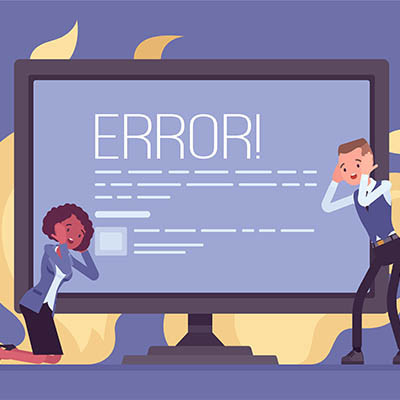Virtual Business Solutions Blog
How often have your operations been disrupted by technology troubles that could have been spotted a mile away? Chances are it’s a little too often for your liking, especially if your business wants to remain profitable. When your operations suffer, so too does your bottom line, leading to losses across the board. How can your organization spot technology troubles before they become detrimental to your organization’s future?
All businesses rely on software to an extent, but there are several that transcend industry or organization size and can be implemented by most businesses to improve productivity. Let’s go over some of the common types of software you might find in a business environment and why you should consider implementing them for your own company.
Cloud computing is being used by nearly everyone nowadays, and most of the time it presents a lot of value that can’t be found with purchasing, managing, and maintaining an in-house computing infrastructure. As an organization begins moving more and more of their computing to the cloud, there is a situation that arises that industry professionals call “cloud sprawl”.
You always read that “business has changed”. This is true because people have changed. More people use their mobile devices for a majority of their communication, their browsing, and a lot more, and it is changing the way business is conducted; it’s just not always easy to separate work use from personal usage. Let’s take a look at some of the ways the smartphone has changed the way people approach work, and how that shift in perspective has changed business.
In popular science fiction, the portrayal of an artificial intelligence is that of an entity completely compelled by pure logic, objective fact being the only thing that factors into its considerations. The same can not be said of the artificially intelligent tools currently in use in the real world. Much like their flawed creators, many of today’s AI systems have presented some considerable biases in their operations. Let’s discuss this issue, and how it can be resolved.
Technology is one element that many small businesses struggle with, but it turns out that a lot of the same advice that you might get for regular life lessons can also apply to IT! Let’s take a closer look at how we might apply some of these lessons and why it just makes good sense to keep these tips close at hand.
You might be familiar with the concept of hosting a service or application in-house on your own server units, and if you are, you know all about the struggles that come along with doing so. But what if we told you that you can get the same benefits of hosting your own applications and IT systems without the need for any of the bulky equipment taking up space in your office? Yes, that’s right—you too can host your business applications, even if you do not have the space to do so, and it’s all thanks to the cloud.
When it comes to implementing new technology solutions for your business, there is always a desire to solve some sort of problem. Maybe you are not as productive as you would like to be, or perhaps there is an operational inefficiency that you hope to address or streamline through the use of the technology. Either way, the end result is the same; you are trying to make progress and move forward, not over-complicate your infrastructure.
Modern businesses rely on a lot of technology to stay operational, much of which can be considered hardware, or the physical computing systems that contribute to your infrastructure, like workstations, routers, switches, and servers. Unfortunately, no technology lasts forever, and this is true for hardware as well. One of the most devastating problems that a business can face is hardware failure, and no matter how well you maintain your technology, you must be ready to face down this threat at any given moment.
For the average business, upgrading technology comes with some risks. Will you get the return on your investment back fast enough to make your investment worthwhile? Will the technology solve the operational problems you are trying to confront? Do you have the available capital to make significant upgrades? These questions and more can keep a business from taking advantage of the amazing benefits many new technologies can bring. Today, we thought we’d outline four signs that will tell you when it’s time to upgrade your business’ technology.
In today’s competitive business environment, you need every edge you can get to one-up your competition and make waves in your chosen industry. One of the best ways you can do so is by strategically implementing technology solutions that can enhance or transform the way your business operates both internally and externally.
For decades, technology has been the driving force behind some of the biggest and most radical shifts in business. Therefore, it makes sense to assume that the keys to your organization pushing past its limits and becoming truly exceptional lies in the implementation of new technologies that change operations in a profound way. The process of digital transformation does not have to be difficult, but it is important in a business environment so that you can stay competitive.
Small businesses often struggle with technology, primarily because they either lack strong IT leadership or they lack the resources to ensure IT maintenance and management happens without a hitch. There are several mistakes that a small business can make when it comes to technology management. Here are four of the biggest and most common that you absolutely cannot afford to make.
A lot has been made about 5G and the way that it is going to significantly alter what is possible, without much mention about the other technology that will fuel this complete digital transformation. We thought that we would talk a little bit about smart technology, how your business can use it to your advantage, and what this technology needs to do to be ready for the world to come.
When you are looking to implement new technology solutions for your business, the last thing you should do is skip the planning process. You need to carefully consider all of your options, your business’ specific needs, and the various benefits that can come from all of these options. Today we will discuss how your business can choose the best technology that suits your organization and its operations.
For some companies, their IT is like a boat to a fisherman: they could conceivably do the work without it, but they wouldn’t have a business. For this reason it is important to know how to ascertain which technology investments are right for your business at any given time. Let’s go through a few considerations decision makers should highlight when choosing new technology for their businesses.
It’s no secret that new technology can be useful for a business, unfortunately too many businesses struggle with their technology implementations. When adding new tools to your business, you will need to understand that the more deliberate you are, the more success you will find. Rushing any new deployment is sure to have some types of issues. For today’s blog, we take you through some of the best practices of adding new technology to your business.
Businesses use cloud resources all the time; and, they use them for many different reasons. Some use them because they have to support a remote workforce, some use them so they don’t have to come up with large swaths of capital or don’t want to pay interest rates for financing their central hardware. Some only use them sparingly to fill in the gaps created by product and service demand.






















